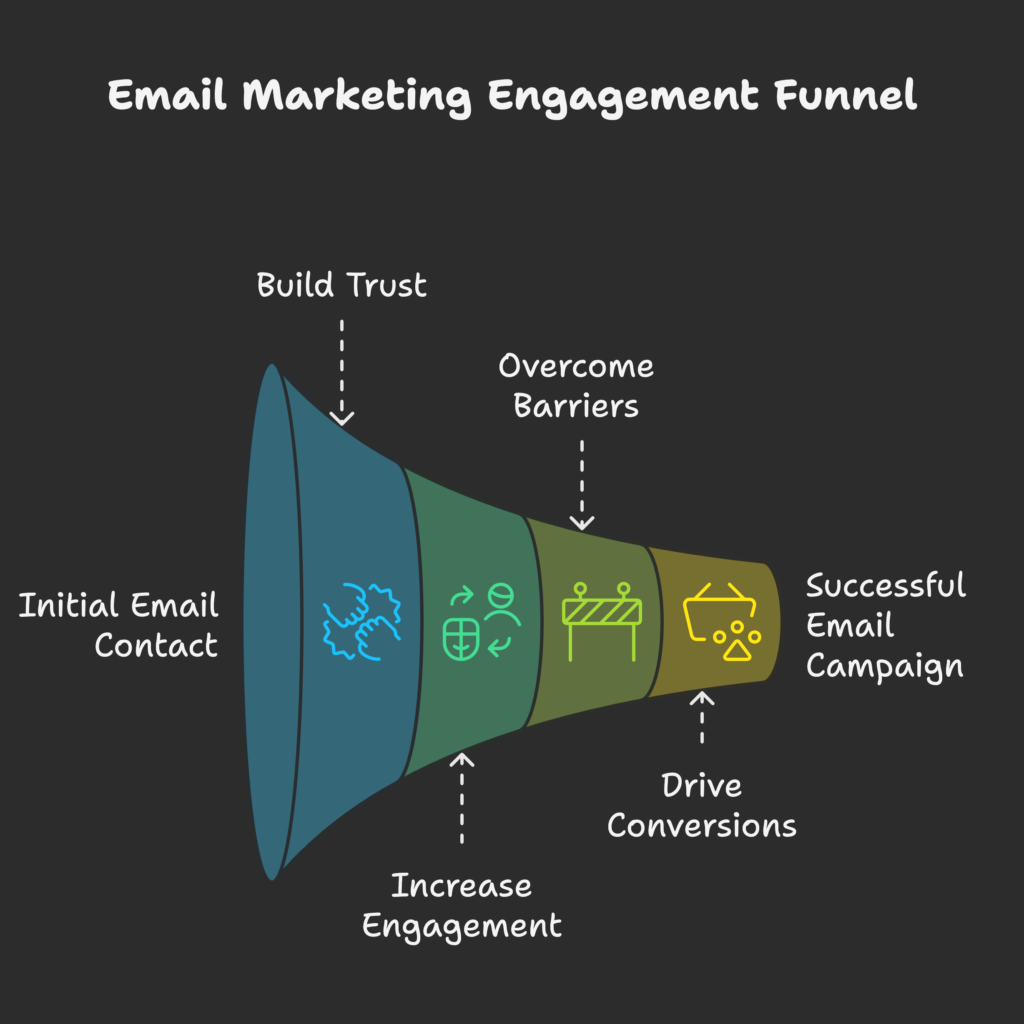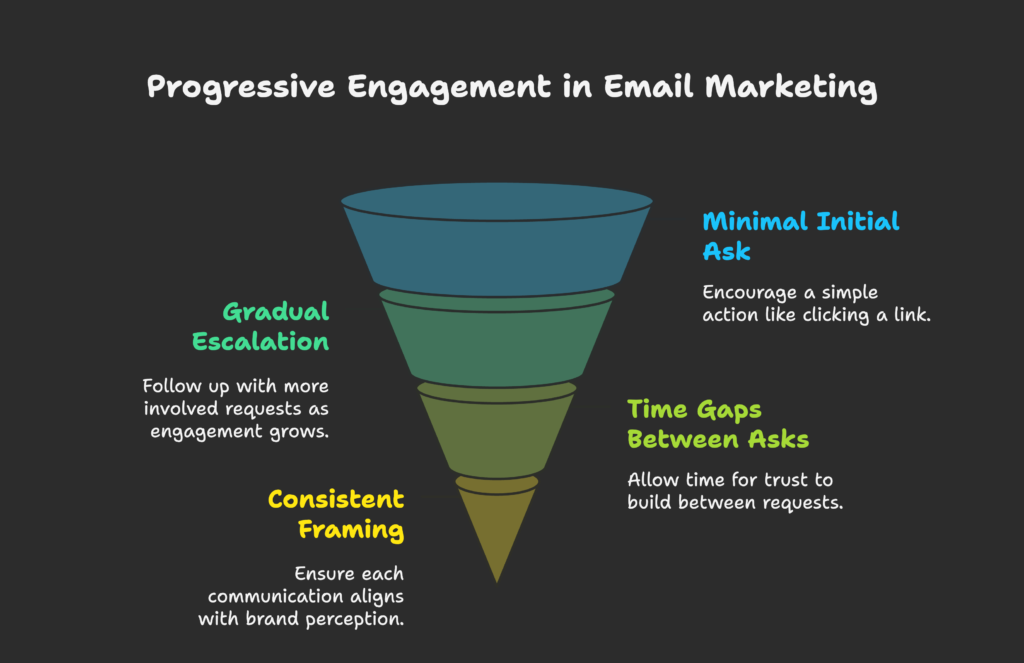Have you ever asked a friend for a tiny favor, and then found it easier to ask for something bigger right after? That’s the “Foot-in-the-Door” phenomenon. Now, imagine applying it to email marketing, where each message nudges subscribers to say “yes” more often. By reading this article, you’ll discover how small, low-commitment requests in emails can build up to major conversions. Ready to learn how subtle persuasion can transform your email campaigns? Let’s dive in!
In this section: We’ll define the Foot-in-the-Door (FITD) technique, explore its psychological underpinnings, and understand why it’s so relevant for modern digital marketing. You’ll see how email marketers can spark bigger actions by starting small.
Definition and Origins
The Foot-in-the-Door technique is a classic persuasion method where you ask people for a minor favor (the “small ask”) and, after they comply, make a larger request. Psychologists Freedman and Fraser first proved its power in 1966 by showing how small initial compliance leads to bigger commitments. Although it started in face-to-face contexts, it’s evolved into a digital marketing mainstay—especially in email sequences. Essentially, once a subscriber says “yes” to something small, they’re more likely to agree to a bigger request later.
Psychological Foundations
Two key ideas explain FITD’s effectiveness: *cognitive consistency* and *self-perception theory*. People like to see themselves as consistent. If they’ve already said “yes,” turning down a related request feels inconsistent. Meanwhile, self-perception means we learn about ourselves by observing our own actions. If you say “yes” once, you start to see yourself as helpful or interested, which boosts your chance of saying “yes” again. These mental dynamics set FITD apart from other techniques like “door-in-the-face” (where you start with a big request, then lower it).
Business Relevance in Modern Marketing
In digital marketing, subtle persuasion is often more effective than hard-sell tactics. FITD stands out because it’s relatively gentle: you’re not pushing too hard early on, which avoids scaring customers away. Studies show that small compliance steps can significantly lift email conversions, especially when combined with trust-building content. As businesses shift from broad ads to personalized messages, using FITD in email sequences offers a straightforward, non-intrusive method to guide subscribers toward bigger actions.
We’ve covered the basics. Next, let’s look at email marketing fundamentals to see how FITD aligns with essential practices.
Understanding Email Marketing Fundamentals
In this section: We’ll explore the email marketing landscape, highlight the importance of email sequences, and see the biggest challenges that hamper email campaigns. Knowing these basics helps you integrate FITD more seamlessly.

The Email Marketing Ecosystem
Today’s inboxes are crowded. Email remains a top marketing channel, boasting an impressive ROI (some estimates around $32 return for every $1 spent). Key metrics include open rates, click-through rates, and unsubscribes. But capturing attention is tough—recipients quickly judge if an email is worth reading or deleting. Building trust and relevance is crucial in this noisy environment.
Email Sequence Architecture
An email sequence is a planned series of messages, often automated or triggered by user behavior. Sequences can welcome new subscribers, nurture leads, or convert one-time buyers into repeat customers. The underlying principle is progressive engagement—each email warms up the subscriber to your brand or product. With FITD, you plant small requests at first, then scale up the ask in later emails to maintain a smooth, compelling journey.
Barriers to Email Marketing Success
- Overload: Too many messages lead to fatigue and unsubscribes.
- Filtering Behaviors: Automated filters and spam rules can limit visibility.
- Lack of Trust: New subscribers often hesitate to engage if they don’t trust the sender.
Fighting these barriers means delivering value, respect, and relevance—exactly the environment where the Foot-in-the-Door technique can shine.
With email fundamentals in mind, it’s time to deep-dive into how exactly FITD applies to email marketing. Let’s see how small steps can pave the way for big conversions!
The FITD Technique Applied to Email Marketing
In this section: We’ll show how to adapt the classic Foot-in-the-Door principle for digital, focusing on small initial asks, creating progressive commitments, and reading subscriber signals to gauge readiness for bigger leaps.

Email-Specific FITD Principles
Traditional FITD might mean asking someone on the street to sign a small petition before requesting a larger favor. In email, your small ask could be a link click or a simple survey. Each “yes”—click, open, or micro-conversion—sets the stage for a more substantial request later. Timing matters: if you escalate too quickly, subscribers might feel pressured. Instead, watch behavior: if they open and click frequently, it’s a sign they’re ready for bigger steps.
Email Sequence Design Using FITD
- Minimal Initial Ask: Something super easy, like “Click here to watch a 2-minute video.”
- Gradual Escalation: Once they’ve clicked, follow up with a mid-level request: “Try our free tool?”
- Time Gaps Between Asks: Don’t push from a small action to a large one immediately; let trust build.
- Consistent Framing: Each email should align with the subscriber’s evolving perception of your brand.
Small Ask Options in Email Marketing
Potential small asks include:
- Survey Participation: “Answer this one quick question” fosters a sense of involvement.
- Content Consumption: Provide a free guide, blog post, or short video. People who consume it become warmer leads.
- Social Engagement: Encouraging a like, follow, or share is often easier than asking for money upfront.
- Account Preference Setup: Nudging subscribers to set content or email preferences invests them in your brand.
Once they respond positively, your next email can ask for a trial sign-up or a product purchase with more confidence.
We’ve explored the “what” of FITD in email. Next, let’s check practical “how-to” strategies for subject lines, content, and landing pages to ensure compliance at each stage.
Implementation Strategies for FITD Email Sequences
In this section: We’ll detail the nuts-and-bolts steps, from crafting subject lines that get small confirmations, to structuring calls to action that build momentum, all the way through landing pages that align with your sequence goals.
Subject Line Engineering
Your subject line is your first small request—“Open me, please!” Keep it short and direct. You can spark curiosity or personal connection. A/B test variations to find which “small ask” resonates best. For instance, “Got 30 seconds? We’d love your quick input!” often performs better than a direct sales approach, easing them into compliance mode.
Email Content Structure
- Gradual CTAs: Start with a tiny commitment, such as a simple click or poll. Subsequent emails ramp up to bigger requests.
- Visual Hierarchy: Make your main “ask” stand out, but not in a pushy way. The rest of the email should support that small step.
- Psychological Triggers: Use a friendly, empathetic tone. Show how easy the next step is—almost “effortless.”
Also, balance value with the request. Ensure each email offers educational or entertaining content so subscribers feel rewarded for engaging.
Landing Page and Post-Click Integration
Once someone clicks, the next page should continue the same conversation. It’s jarring if your email promises a “quick survey” but the landing page shows a 10-minute questionnaire. Keep the form simple, or break it into steps to maintain that sense of small ask. If they complete that step, you can elegantly introduce a more substantial request or product pitch right after—still harnessing the momentum of compliance.
We’ve set up the framework. Now let’s see how these tactics shape entire email sequences, from lead generation to e-commerce flows.
FITD Email Sequence Models and Examples
In this section: We’ll present typical email campaign scenarios—like lead generation or free trials—and show how the Foot-in-the-Door approach can power each stage, from the first “hello” to the final conversion.
Lead Generation Sequences
- Initial Offer: A simple request like “Download this free checklist” establishes the first step.
- Mid-Sequence Engagement: Once they respond, follow up with an invite to a webinar or quiz, gradually upping involvement.
- Final Conversion: With trust and involvement built, now is the time to pitch a paid consultation or premium membership.
Example: A marketing consultant might start with a free PDF, then propose a short discovery call, culminating in a full paid session offer.
Free Trial to Paid Conversion Sequences
If you run a SaaS business, your small ask can be a free trial sign-up. Once the subscriber accepts, send emails to nudge them to explore features and get comfortable. Over time, highlight upgrade benefits or advanced capabilities. By the time the trial ends, they’ve taken multiple small steps (exploring modules, customizing settings) that make the paid plan the natural next step.
E-commerce Purchase Sequences
Start by asking the subscriber to simply *add an item to their wishlist* or create an account. Then, move to a small purchase or free shipping code. Once they get comfortable with minor transactions, larger purchases or cart expansions feel more natural. If they abandon the cart, a re-engagement email might propose a small discount as another easy step. Eventually, you can upsell or cross-sell bigger-ticket items.
We’ve seen how sequences might look. Next, we’ll explore how to measure whether your FITD approach is truly delivering results.
Measuring FITD Effectiveness in Email Marketing
In this section: We’ll delve into metrics and testing strategies that let you see if your gradual-ask approach actually lifts conversions and fosters long-term customer value.
Key Performance Indicators
- Compliance Rate: Percentage of subscribers who respond to the small ask, indicating early success.
- Sequence Progression Metrics: How many move from the first email to the second, from the second to the third, etc.
- Time-to-Conversion: How quickly do people go from small ask compliance to bigger commitments?
- Lifetime Value (LTV): Often, an effective FITD approach raises loyal spending over time.
Testing Methodologies
Conduct A/B tests where half of new subscribers see a FITD-style sequence, and the other half see a direct sales approach. Track open rates, CTR, and final conversion. You can further refine these sequences by adjusting the length of time between the first small ask and the next bigger one. Also consider segment-based tests—some audiences might prefer faster escalations, while others need more time.
Attribution Models for FITD Analysis
Because a small ask might lead to bigger actions across several emails, standard “last-click” models may undervalue early compliance. A multi-touch approach credits each email and each small step that contributed to the final sale. This helps you see the true impact of the initial micro-commitments and refine the entire chain for maximum effect.
Now let’s dive deeper into advanced techniques that use personalization, machine learning, and cross-channel synergy to supercharge your FITD campaigns.
Advanced FITD Email Techniques
In this section: We’ll show how to customize your sequence further through segmentation, predictive models, and coordinated multi-channel strategies. After all, better data and integrated marketing can raise your persuasion power significantly.
Personalization and Segmentation Strategies
Tailor initial asks to each segment’s known interests. If someone has visited your blog on “green living,” start with a small eco-friendly tip or product sample. Another group might prefer a quick poll about productivity tools. By delivering the right small ask at the right time, you boost the likelihood of an early “yes,” building momentum for bigger conversions.
Machine Learning Applications
AI can predict which email topics or frequency best fit each recipient, automatically adjusting the small ask or the time gap between emails. Natural language processing also helps craft subject lines that resonate with each group’s preferences. Some advanced systems can even detect “readiness” signals, triggering the next step in the sequence once a threshold of engagement is reached.
Multi-Channel FITD Integration
Email might be your main stage, but you can also apply the same principle across social media ads or remarketing. A subscriber who clicked an email link might see a gentle follow-up on Facebook or Google, asking for the next small step. Integrating these channels ensures consistent messaging, so the second or third small request feels natural wherever they browse.
Let’s not forget about ethics. As with all persuasive tactics, we need to be upfront and fair. Let’s explore how to do that next.
Ethical Considerations and Best Practices
In this section: We’ll discuss how to use the Foot-in-the-Door technique responsibly. We’ll cover transparency, value exchange, and the pitfalls of overly aggressive sequences that might harm rather than help relationships.
Transparency and Consent
Always let subscribers know what data you collect and how you plan to use it. Overstepping privacy boundaries in pursuit of compliance can lead to distrust. Emphasize that subscribers can opt out or adjust preferences at any time. Being honest fosters long-term loyalty and respect, essential for any repeated compliance approach.
Value Exchange Equilibrium
As you escalate requests, ensure you provide real value each time. If your second email asks them to do more, it should also offer more in return—like an in-depth resource or a special discount. Failing to balance this exchange can feel manipulative and cause unsubscribes or brand backlash.
Avoiding Common Pitfalls
Going too big, too fast is a major error—recipients can feel cornered. Frequency that’s too high can also backfire, causing email fatigue. If your metrics show rising unsubscribes or low engagement after a new request, consider scaling back or extending the time between steps. Sometimes, rebooting the sequence for unresponsive subscribers can re-engage them if done carefully.
We’ve handled the ethical side. Next, let’s see what the future holds for FITD in email marketing—from new tech to emerging research in persuasion science!
Future Directions and Innovations
In this section: We’ll look at upcoming technologies, cross-platform synergy, and new research that could shape how we do email marketing with the Foot-in-the-Door technique.
Emerging Technologies
- AI-Driven Real-Time Adaptation: Automated tools that adjust the next email’s request based on recipient behavior or emotional cues.
- Enhanced Personalization Engines: Deeper data analyzing language style, purchase patterns, and user feedback to craft the perfect small ask.
- Interactive Email Experiences: Let users fill out mini-forms or polls inside the email, instantly responding to small requests without leaving their inbox.
Cross-Platform Evolution
Email marketing is rarely standalone. Marketers are blending chatbots, push notifications, and in-app messages. A small ask started in an email might be reinforced via a retargeting ad or a chatbot reminder. This synergy ensures the user sees a consistent message across channels, further boosting compliance.
Research Frontiers
We’ll likely see more neuromarketing studies on how exactly small compliance shapes brain activity and brand perceptions. Cultural differences in responding to FITD might also come to the fore, showing how some societies are more communal, thus more receptive to step-by-step compliance. Additionally, there’s growing interest in the long-term effect of repeated small asks—does it sustain trust, or does it lead to user fatigue over time?
All right, you’re almost a pro in the Foot-in-the-Door technique for email. Let’s provide a final, concise guide to get you started—and share some case studies for inspiration!
Implementation Guide and Frameworks
In this section: We’ll outline a quick checklist for building your own FITD email sequence, discuss how different industries can adapt it, and share real-life examples of success.
FITD Email Sequence Implementation Checklist
- Plan Your “Small Ask”: Identify a simple, low-risk action—like a 1-click poll or free content download.
- Map Escalation Steps: Plot out the next 2-3 bigger requests, each logically growing from the last.
- Develop Sequence Content: Craft each email’s copy, ensuring it reaffirms value and fosters trust.
- Schedule Testing & Iteration: Use A/B tests to refine subject lines, timing, and request size.
Industry-Specific Applications
- B2B Services: Start with a free whitepaper, then propose a short call, ending with a full demo or pilot program.
- E-commerce: Offer a mini coupon or product quiz, then move to recommended items, finishing with a bigger bundle deal.
- SaaS & Subscriptions: Start with a free trial or a partial feature, then expand to the full paid plan, eventually cross-selling advanced add-ons.
Case Studies and Success Stories
For example, a digital marketing agency tested an email sequence where the first email simply asked for a one-question response: “What’s your biggest marketing challenge?” Over 40% replied—a small but crucial commitment. Next, they offered a 15-minute consultation (with 22% acceptance), leading to a final sales pitch with a 10% close rate. This incremental compliance overshadowed their previous single-shot approach, which saw only a 2% conversation rate. By building trust and interest step by step, they significantly boosted conversions.
Quick Note: If you have a Shopify store and want to power up your email marketing, consider the Growth Suite application. It helps design strategic email sequences, integrates with your store data, and guides subscribers through the perfect “Foot-in-the-Door” journey—paving the way for better conversions and higher sales.
References
- Freedman, J. L., & Fraser, S. C. (1966). Compliance without pressure: The foot-in-the-door technique. Journal of Personality and Social Psychology, 4(2), 195-202. (Referenced in multiple search results)
- Voucherify.io. (2025, March 1). The Foot In The Door Technique Explained with Examples
- LinkedIn. (2024, July 3). Foot-in-the-door Marketing
- HubSpot. (2022, January 12). 7 Powerful Ways to Make Your Emails More Persuasive
- Limehub. (2024, June 19). The Foot-in-the-Door Technique
- Psychologist World. (2017, January 13). Foot-in-the-Door as a Persuasive Technique
- Vbout. (2020, January 13). Using the foot in the door technique to increase email engagement
- Talon.one. (2022, March 21). Use the ‘foot in the door’ technique in promotions
- Tapform.io. (2025, March 7). Mastering the Foot in the Door Technique
- CXL. (2023, May 1). Foot In The Door Technique (FITD): Using Persuasion to Convert
- Tuten, T. L. (n.d.). Getting a foot in the electronic door: Understanding why people read or delete electronic mail. Semantic Scholar. Link
- Mailchimp. (2024, October 8). Email Marketing Strategy Tips From Industry Experts
- Agile CRM. (2020, June 8). 18 Types of Sales Email Templates for Lead Generation




